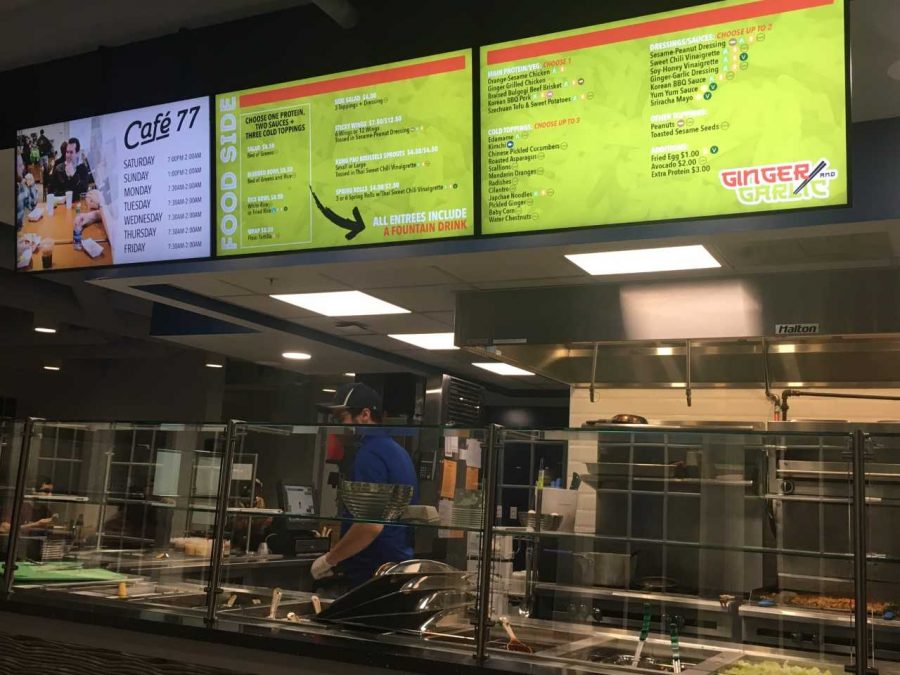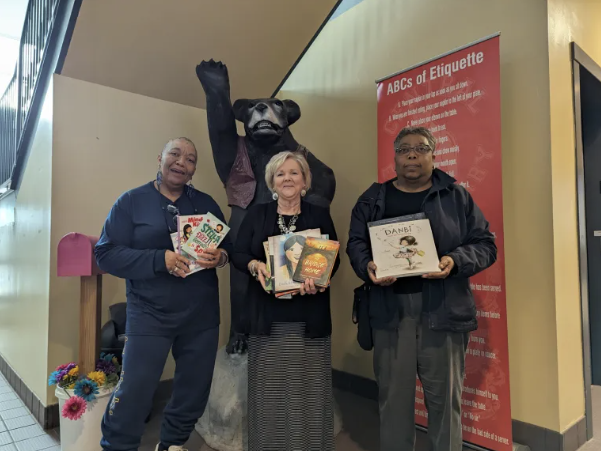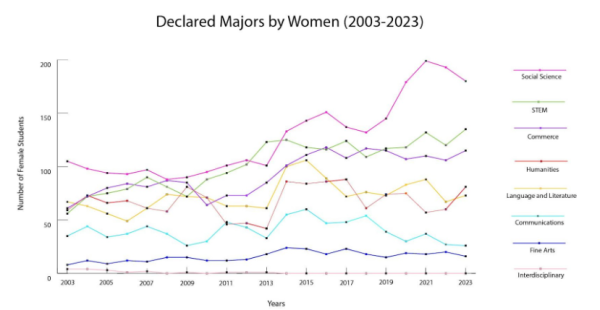Asian students question authenticity and purpose of Foodside’s former menu
Director of Dining Services said Ginger and Garlic’s menu was designed with “cross-section of flavors and ingredients” in mind.
The Ginger and Garlic menu was offered by Foodside from the beginning of the winter semester until February break. Photo by Ben Soullier, ’19.
March 4, 2019
The menu for Washington and Lee’s Foodside restaurant changed again last week, but there are still lingering questions about the authenticity of Foodside’s previous option.
Most students interviewed for a previous article had no problems with the quality of food served at Ginger and Garlic. However, several students felt the restaurant failed to meet the standards of authentic Asian cuisine. Anukriti “Anu” Shrestha, ‘19, who is from Kathmandu, Nepal, said she believes that while some students liked the food, the way it was presented was confusing.
“In my experience, I’ve talked to seven or eight students, and people are kind of confused because they are trying to keep the same system from when it was a Mexican restaurant,” Shrestha said. “So build your own bowl or a fried rice burrito doesn’t quite work for Asian food in my opinion.”
Shrestha said she thought the idea of the “fusion bowl,” where students can make meals with whatever ingredients the restaurant offered, worked really well for the Cantina Grill—affectionately known to students as MexiCoop—but not for Ginger and Garlic.
“They’ve taken things that are common in these cultures and you don’t quite know what to pair it with,” Shrestha said.
Other students shared similar concerns about the restaurant’s authenticity. Tiffany Ko, ‘20, is from Bristow, Virginia, and is Korean-American. Her parents came to the United States from Korea for college and graduate school.
“The biggest way I connect to my Korean culture is through food,” Ko said. “I honestly think out of all the menu items that they referred to as Korean, the only thing that I would be able to recognize is kimchi. The pork, brisket and noodles I do not think I would be able to recognize as Korean outside of the labels the restaurant uses. The way that it is now makes me a little uncomfortable because the things that are labeled authentic Korean or Chinese food are not what I have experienced as authentic.”
Ko said she thinks the problem comes from an American understanding of Asian foods. She said she believes Ginger and Garlic adopted that style as opposed to a more authentic style of Asian cuisine.
“Most of the foods they have at third year are examples of American-style Chinese foods as opposed to authentic Chinese food,” Ko said. “They do it well, but it is not necessarily authentic food. But I don’t think the purpose of the restaurant is to be a completely authentic experience.”
Like Shrestha, Ko thought the “fusion bowl” was a strange way to present East Asian dishes.
“I think the bowl is a little strange to me because I don’t usually put orange chicken in a bowl,” Ko said. “In Korean cuisine, there is a specific type of bowl, so something like that I would be comfortable with. But right now it seems like they are trying to fit Asian cuisine into this bowl standard that they have.”
But Ko still chose to eat at Ginger and Garlic when it was available for the first six weeks of the semester.
“I eat there once or twice a week. It’s a good option for food on campus compared to, for example, the dining hall, because you get more options,” Ko said.
Another student, Yue “Abby” Yu, ‘20, from Dayton, Ohio, described how important Chinese cuisine is to her and her family. Yu’s family is Chinese and she speaks Mandarin at home, where she eats a lot of authentic food.
“Some of the ingredients [Foodside] use[s] are not authentic,” Yu said. “We would not eat orange chicken, Brussel sprouts or rice with romaine lettuce. We don’t use toppings like they do.”
Yu also believed the “fusion bowl” was a poor choice for serving Asian cuisine.
“The fusion bowl does not really work for Asian cuisine,” Yu said. “We like to have things separate such as a vegetable dish, a meat dish and then rice on the side.”
All three students believed that the quality of the food was high.
“The quality I think is fine, though,” Yu said. “I do enjoy eating there because it does have authentic elements. Overall I would like to eat there [more] than other places on campus.”
In terms of how Ginger and Garlic could change the preparation of their food if Foodside provides that menu again, Yu was specific about what she believed could help the restaurant be more authentic.
“My suggestions would be not having the romaine lettuce with the rice,” Yu said. “The sauces were fine, but I would like to see some of the vegetables prepared as a dish. Also, I would like to see a stir fry option.”
Shrestha had suggestions for Foodside as a whole.
“I think six weeks is too short. I wish they stuck it out for an entire semester,” Shrestha said. “I would like to see something stay for a whole semester.”
Ko had several suggestions for how Ginger and Garlic can work to improve the authenticity of their food the next time Foodside attempts Asian cuisine.
“They should maybe do a little bit more background research into the words that are being used,” Ko said. “For example, Japchae is a Korean dish that uses glass noodles, with beef and mushrooms and carrots and spinach and sesame seeds. So there’s a lot to it, but the way they do it is just noodles, so that’s not the right word to use for their dish.”
Director of W&L’s Dining Services Jennifer Hickey assured the Phi in an email that Dining Services goes to great lengths to make sure their products are labeled correctly. Hickey added that they worked hard on educating their staff on all ingredients and dishes.
“Our culinary team works hard to develop menus and flavors that will appeal to the widest variety of students, while still maintaining as much authenticity as possible,” Hickey said. “If a student or customer ever feels we have mislabeled a specific ingredient, we always encourage them to let us know. In the case of the japchae noodles, perhaps we should have labeled them as “japchae-inspired noodles”–our ingredient was a cellophane noodle that was marinated in the Korean flavors of a japchae stir-fry.”
Hickey also talked about protecting the authenticity of the food.
“Throughout W&L Dining, we make every attempt to provide flavorful, nutritious, well balanced meals to our students and staff. The menus at Foodside are designed with the fast casual concept in mind,” Hickey said. “With that said, the goal of Ginger and Garlic was not to reproduce any single Asian culture’s cuisine with 100 percent authenticity. Instead, we designed the menu to present a cross-section of flavors and ingredients that we felt would mesh well and allow students to customize their favorite flavors while experimenting with some new ones.”
Hickey added that Foodside is never fully authentic.
“Cantina does not necessarily provide fully authentic Mexican dishes but rather a sampling of flavors from throughout Latin America, and our current Meze Feta menu does not aim to reproduce the cuisine of any one country, but rather present choices from throughout the Mediterranean region,” Hickey said.
Hickey stated that Ginger and Garlic will most likely be an option at Foodside again next year. She said they will carefully examine the feedback they have received, both positive and negative, and will work to improve their menu.
Ko said she appreciated Foodside for attempting and offering Asian cuisine on campus.
“I do want to applaud them for branching out, and I really appreciate that,” Ko said. “But I do think if they are going to be committed to branching out that it would be worth their time and investment to dig a little deeper in their research of the food.”













